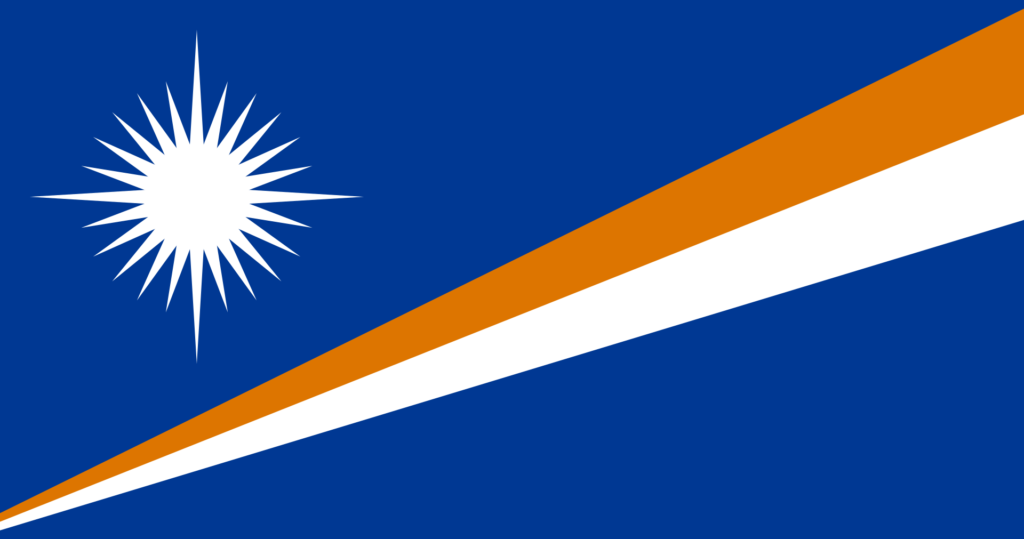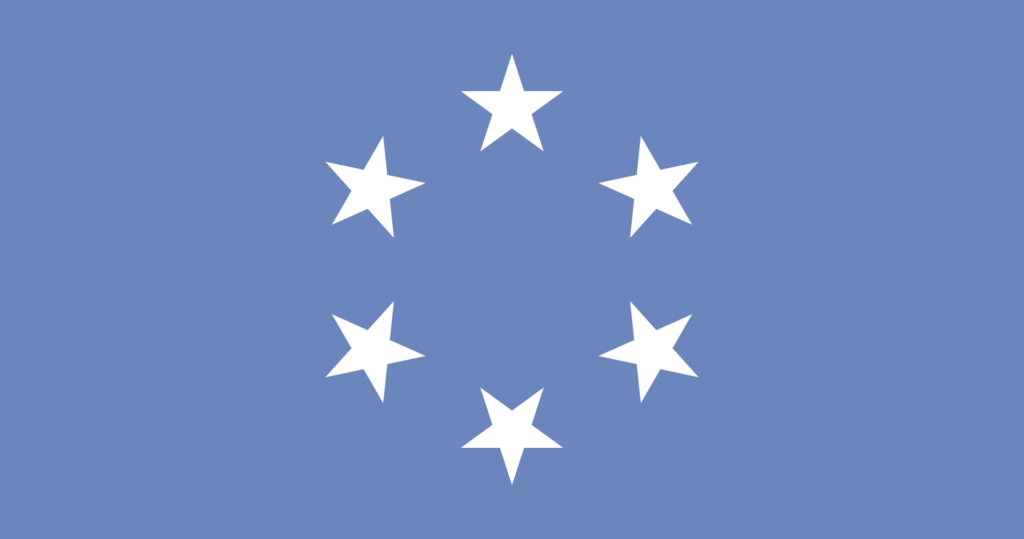The Marshall Islands were constantly under a protectorate until 1979. In 1886 the patron was Germany, from 1914 Japan, and after World War II the United States.
This is what the modern flag of the Marshall Islands looks like:

History of the flag
The Marshall Islands previously used the UN flag (1947-1965).

Then the flag of the U.S. Trust Territory of the Pacific Island (1965-1979).

On June 12, 1979, by the design of the first lady of the state, Emeline Kabua, the flag of the Marshall Islands became the national flag. This was as a result of the acquired independence from the United States, under whose tutelage the country had been.
Description of the Marshall Islands flag
Presented in the form of a rectangular blue cloth. In the upper left corner is a white star, which has 24 pointed rays. From the bottom left corner, diagonally, two rays of white and orange.
Executed in blue, white and orange tones.
Meaning of colors and symbols
- Blue symbolizes the Pacific Ocean in which the archipelago is located.
- White symbolizes the desire for world peace.
- Orange represents the bravery and courage of the nation’s people.
- The white star stands for the Christian cross, and its rays represent the number of constituencies in the state. It is also placed on the coat of arms and seal of the country.
- The two stripes stand for the two chains of islands that make up the archipelago, Ratak and Ralik.
Interesting Facts
The flag is not forbidden to be used by private persons, public organizations or public authorities for any action on land. At sea, it may only be flown on private ships, merchant ships or government ships.
General information about the Marshall Islands
| Official language | Marshallese, English |
| Capital | Majuro |
| Territory | 181,3 km2 |
| Population | 55 000 people |
| Currency | US dollar (USD, code 840) |
| Phone Code | +692 |










I visited the Marshall Islands last summer and was so captivated by their gorgeous flag! It reminded me of the vibrant sunsets we witnessed there. I’m really thankful for that experience and the warm hospitality of the locals. Their culture is truly inspiring!
I remember when I visited the Marshall Islands and saw their flag waving in the breeze. It felt so vibrant and full of hope. The colors reminded me of the beautiful sunsets there. I’m really grateful for that experience; it deepened my appreciation for different cultures!
I visited the Marshall Islands last year and was amazed by their flag! The vibrant colors really represent their unique culture and history. I chatted with locals who shared stories about what the flag means to them. It’s a beautiful symbol of resilience and pride!
I remember when I first saw the Flag of the Marshall Islands while studying Pacific cultures. Its vibrant colors really stood out! It inspired me to learn more about their history and traditions. Flags can tell such powerful stories about identity and heritage!
I visited the Marshall Islands last year and was blown away by the beauty of their flag. It reminded me of my own journey there. The colors symbolize hope and unity, just like the amazing people I met. I’m so grateful for that experience!
I visited the Marshall Islands once, and their flag really stood out! The vibrant colors and unique design represent the islands’ history and culture. It reminded me of how important our roots are. Seeing it fluttering proudly made me appreciate the beauty of diversity in our world!
I once visited the Marshall Islands and was blown away by their flag! The vibrant colors and stars tell such a unique story. It reminded me of the importance of culture and heritage. Learning about their history was an unforgettable experience! Can’t wait to go back someday!
I remember when I first learned about the Flag of the Marshall Islands in school. It’s so colorful and unique! I was amazed at how each color represents something special about the culture and history. It really sparked my interest in different flags around the world!
I totally get that! Learning about flags can be so inspiring. I remember being fascinated by the colors of the Ghanaian flag and how they symbolize independence and unity. It really opened my eyes to the stories behind each country’s identity. Flags are like windows into culture!